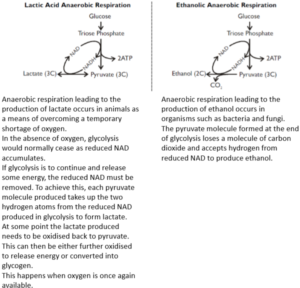If there is no oxygen (anaerobic conditions) then the final reaction to make water cannot take place. Electrons can’t leave the respiratory chain, and so NADH cannot unload any hydrogens to the respiratory chain.
This means that there is no NAD in the cell; it’s all in the form of NADH. Without NAD as a coenzyme, some of the enzymes of the Krebs cycle and glycolysis cannot work, so the whole of respiration stops.
For glycolysis to continue its products of pyruvate and hydrogen must be constantly removed. In particular, the hydrogen must be released from the reduced NAD in order regenerate NAD.
Without this, the already tiny supply of NAD in cells will be entirely converted to reduced NAD, leaving no NAD to take up the hydrogen newly produced from glycolysis. Glycolysis will then stop.
The replenishment of NAD is achieved by the pyruvate molecule from glycolysis accepting the hydrogen from reduced NAD.
Some cells can get round this problem using anaerobic respiration. This adds an extra step to the end of glycolysis that regenerates NAD, so allowing glycolysis to continue and some ATP to be made. Anaerobic respiration only makes 2 ATPs per glucose.
There are two different kinds of anaerobic respiration:

